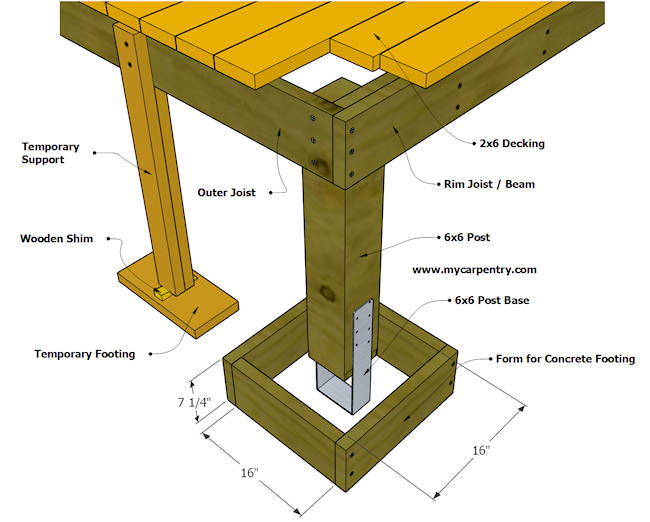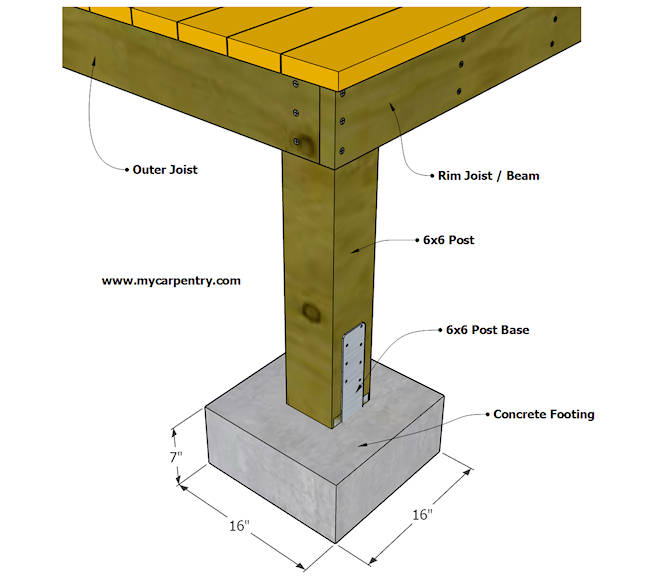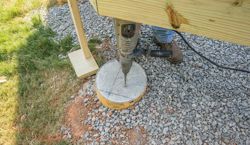Professional Tips for Putting Up Deck Footings to Support Your Outdoor Room
When it comes to constructing a deck, one of the most important elements to take into consideration is the installment of appropriate grounds. These footings are the foundation upon which your exterior space will certainly rest, supplying stability and support for years to come. What specifically does it take to set up deck footings properly?
Value of Appropriate Deck Footings
Proper deck grounds are necessary for making sure the security and durability of your outdoor room. Without strong and properly mounted grounds, your deck may come to be unsteady, leading to safety and security dangers and expensive repairs.

In addition to security, appropriate deck footings also add to the long life of your outside room (Deck Footings). Grounds that are created and built to endure the elements and soil conditions in your location will help stop the deck from clearing up or shifting with time. By making certain the grounds are appropriately sized and installed, you can decrease the risk of damage to the deck structure, expanding its life expectancy and reducing the demand for pricey fixings or replacements

Choosing the Right Type of Footings
When choosing the proper kind of footings for your deck, it is necessary to take into consideration variables such as dirt problems, neighborhood building codes, and the overall style of your outside area. The kind of footing you select will play a critical duty in making certain the security and longevity of your deck.
One usual type of ground is the concrete footing. Concrete footings are appropriate for most soil conditions and offer exceptional support for decks.
Sometimes, you may require to utilize specific footings, such as pile grounds or deep structures, if you are constructing a huge or multi-level deck. These footings are designed to distribute the weight of the deck over a larger location, making certain security and avoiding sinking or resolving.
Prior to choosing a kind of ground, it is important to get in touch with neighborhood building ordinance and policies to ensure conformity. In addition, take into consideration the style and intended usage of your outside area. Factors such as the dimension, shape, and load-bearing requirements of your deck will influence the kind of footing that is most ideal.
Preparing the Ground for Footing Setup
To properly prepare the ground for footing installment, it is important to examine the soil conditions and take essential actions to guarantee stability and longevity of the deck. The very first action is to dig deep into the area where the footings will certainly be mounted.
Once the area has been excavated, the next action is to portable the dirt. This can be done using a plate compactor or by utilizing a hand meddle. Compacting the soil helps to remove any kind of gaps or air pockets, which can bring about resolving and instability gradually.
After condensing the soil, it is essential to lay a layer of gravel or crushed rock at the end of the excavation. This will certainly offer water drainage and assistance to avoid water from pooling around the grounds, which can cause erosion and instability.
Step-by-Step Overview to Putting Up Deck Footings
After correctly preparing the ground for footing setup, the next step is to begin the process of mounting deck footings. This step-by-step overview will certainly provide you with a clear understanding of how to install deck grounds for your exterior area.
Determine the area: Start straight from the source by noting the settings of the deck footings making use of risks and string. Ensure next page that the areas align with the layout and format of your deck.
Dig the holes: Make use of a message hole digger or an auger to dig the openings for the footings. The depth and diameter of the holes ought to remain in accordance with local building regulations and the details requirements of your deck layout.
Level the holes: Utilize a degree to make sure that the openings are dug to the correct depth and are degree with each various other. (Deck Footings)
Include gravel: Place a layer of gravel at the end of each opening to enhance drainage and avoid the wood from decomposing.
Place the footings: Put the grounds into the holes, ensuring they are degree and plumb. Use a level and a gauging tape to guarantee accuracy.
Secure the footings: Put concrete into the holes around the footings, loading them to the top. Make use of a blog post degree to make certain the grounds continue to be degree as the concrete collections.
Allow time for treating: Let the concrete cure according to the producer's guidelines prior to waging the deck construction.
Common Blunders to Prevent During Footing Installation
One important facet to consider during the installation of deck footings is staying clear of typical errors that can compromise the stability and long life of your outside space. While deck footings may appear like a basic and simple part of the building process, overlooking specific variables can result in expensive repairs and prospective safety risks down the line.

Furthermore, neglecting to install appropriate drain actions can trigger water to build up around the grounds, causing rot, degeneration, and the ultimate weakening of the deck's structure. In addition, making use of the incorrect kind of footing material or Full Report stopping working to properly protect the grounds can compromise their structural integrity.
To stay clear of these mistakes, it is important to talk to a specialist or follow sector guidelines to make certain proper footing setup. By doing so, you can make sure the stability and durability of your outside area, giving a enjoyable and secure setting for many years ahead.
Conclusion
In conclusion, mounting appropriate deck grounds is essential for the stability and durability of your outside space. By selecting the appropriate sort of grounds and properly preparing the ground, you can guarantee a strong structure for your deck. Adhering to a detailed overview and staying clear of usual mistakes during footing installation will further enhance the sturdiness and safety and security of your deck.
Correct deck grounds are crucial for ensuring the security and long life of your outdoor room. The grounds serve as a connection between the deck and the ground, allowing the weight of the deck and its occupants to be dispersed equally right into the soil.One typical kind of footing is the concrete footing. Put the grounds: Place the footings into the openings, making sure they are level and plumb. Safeguard the grounds: Pour concrete into the openings around the grounds, filling them to the top.